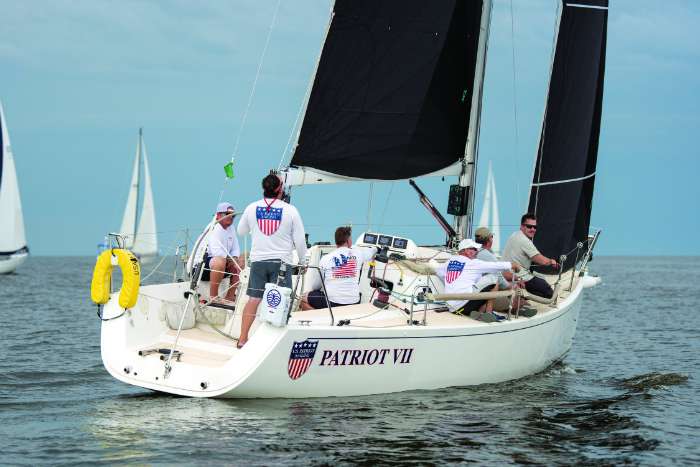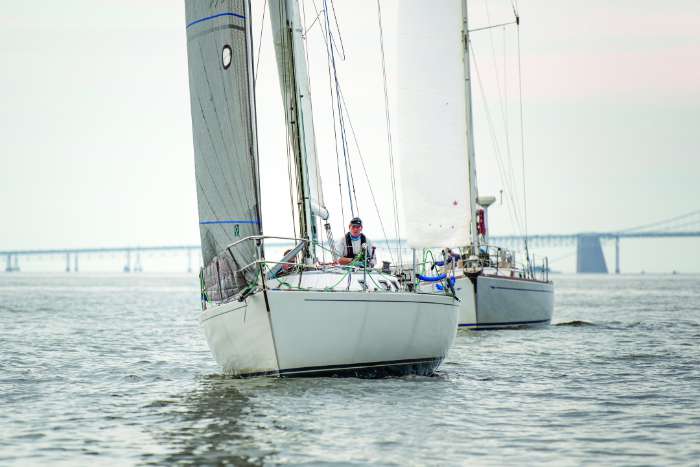Light Wind Sailboat Racing Tips… Again
It has been five or six years since we last addressed the dreaded topic of racing in light air. Probably because it is one of my least favorite things to do. But it is getting to be that time of year (certainly here on the Chesapeake Bay), and there are going to be plenty of races where we just don’t have a choice. So, in no particular order or relevance, here are some thoughts on winning in “sub-optimal” conditions.

Attitude
We need to embrace the fact that light air racing is often a bit of a crap shoot. I am the worst at this. Sailboat racing has enough uncontrollable variables in the best of conditions. The lighter the breeze the greater the number of variables, most of which are out of control. Be prepared for having the breeze die just after you have established an unassailable lead while you watch the whole fleet sail up to you. Or maybe seeing the time limit expire just as you approach the finish line. These and other tales of woe come with the territory. You just have to laugh and accept the injustice of it all. The good news is that sometimes we are the lucky ones and get that last puff that puts us over the edge. Remember that in light air it is never over.
Race committee
It is easy to hate the race committee in light air. Why are they trying to run this race? There is no wind. We just had a 50-degree shift. What are they thinking? Keep in mind that they are struggling just like you. Getting a course set up and a start off in light, shifty conditions is hard. They are volunteers doing their best. The overriding goal is to try to get a race off. Now this may be wrong, but it is driven into them. Hopefully when they see that the last two classes to start are still on the line mixing with the class that is trying to start, they will see the error in their ways. It is okay to not start a race or abandon one. Sometimes wind, the key ingredient we all depend upon, just does not cooperate. Above all, have a heart and sympathize.
Controllable variables
Any one-design sailor knows these basic fundamentals. Handicap sailors need reminding. We can make sure our boat is ready for light air by addressing two issues. First, the bottom must be perfect. Any slime or growth will have a dramatic impact on boat speed. Bottom perfection is more critical in light air than in heavier air. No amount of time spent fairing or cleaning is wasted. You have to wipe the bottom down before every race. Second, get rid of the weight. Stuff onboard has a habit of accumulating. Boat speed is a direct reflection of horsepower-to-weight ratio. You can control one half of this equation, and it is free! Clients are always coming to me looking for the magic elixir of the perfect sail or piece of equipment. Put your boat on a diet. It is the easiest way to improve speed in light air.

Speed first
When it comes to making the boat go in light air, one needs to keep in mind the golden rule: speed first. When sailing upwind, we need to resist the temptation to point. Keep the nose down and rumble. Be very careful when you try to steer towards the high side of the groove. Don’t get greedy with height. In variable conditions you will need help from your trimmers. You cannot steer fast enough to keep up with the telltales. Sails will need to be eased and trimmed to help you keep up and refrain from over steering. Likewise, when downwind keep the pressure up. Err on the side of speed. Resist the temptation of sailing deep, even if that is where the mark is.
The other thing which helps the helmsperson is heel. Heel creates weather helm and helps with feel. Keep the weight forward and to leeward. Most racer/cruisers have relatively small cockpits which tend to attract lots of bodies. Get them out of the cockpit and forward up by the shrouds. It’s okay and often a lot more comfortable to go down below. Who wants to watch anyway? Food can be a good incentive. In the puffs slide a body or two at a time up to maintain a consistent angle of heel. Finally, movement kills speed, so everyone needs to stay frozen in place and when movement is necessary, move like a cat.
Starts: low density wins
It is always a good idea to stay out of clumps of boats around the starting line. In light air it is critical. There is less breeze to go around in a pack, and you simply can’t live with another boat anywhere near you close to leeward if you are going to be reaching and building speed in the last minute. It can be especially difficult because in light air it often pays to push the ends of the line, something we usually stay away from in normal conditions. The surest way to clear air and the ability to put the bow down and accelerate is to start at the pin, or failing that at the boat end with a quick tack. Your choice of which end comes down to which side of the course looks best. Light air starts require more commitment than normal. You just can’t be conservative.
Pressure rules
Just as at the start, you are not going to win many light-air races by sailing up the middle. You really have to be ready to hit an edge. In normal races wind shifts, pressure (velocity), and current are weighted relatively evenly. In light air races pressure and current dictate strategy.
Sail to the side where you think there is more wind and less adverse or more positive current. A small increase in wind velocity pretty much outweighs anything else. Don’t worry as much about the small wind shifts. The most difficult legs are the ones where the current says go one way and the velocity says go to the other side. Say you need to go left to get out of the current, but there seems to be more pressure to the right. A good place to be to hedge your bets would be to the right of the bulk of the fleet as you headed left, shepherding them to the current favored side while staying closer to better pressure.
All in all remember to have fun. Light air racing is a lot like gambling. You are going to have to take risks, and you will need some luck. Sometimes the best laid plans are going to go awry. Embrace it!
Questions? Email David Flynn at [email protected]
Find more sailboat racing tips here.




